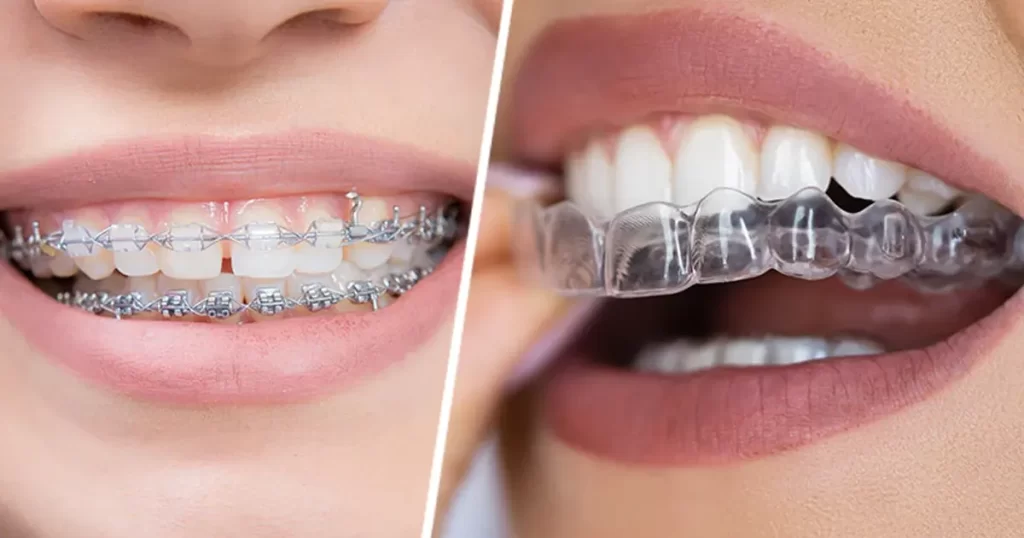Orthodontic treatment plays a crucial role in enhancing both the aesthetics and functionality of teeth, offering individuals the opportunity to achieve a straighter, more aligned smile. With advancements in dental technology, patients now have the option to choose between clear braces and traditional metal braces. However, the question remains: Which is better? In this comprehensive guide, we’ll explore the key differences between clear braces and metal braces to help you make an informed decision.
Understanding Clear Braces and Metal Braces
Clear Braces:
Clear braces, also known as clear aligners, are discreet orthodontic appliances made of transparent plastic material. They are custom-designed to fit snugly over the teeth, gradually shifting them into alignment. Clear braces offer a less noticeable alternative to traditional metal braces, making them particularly appealing to individuals seeking a more aesthetically pleasing treatment option.
Metal Braces:
Metal braces consist of metal brackets attached to the front surface of teeth, connected by wires and secured with elastic bands. Despite their conspicuous appearance, metal braces remain a popular choice for orthodontic treatment, especially for cases involving severe misalignment or complex dental issues. They provide robust and reliable correction, effectively straightening teeth over time.
Comparing Clear Braces and Metal Braces
Appearance:
Clear braces are virtually invisible, blending seamlessly with the natural tooth color and minimizing the visibility of orthodontic treatment. In contrast, metal braces are more conspicuous due to their metallic appearance, making them more noticeable when smiling or speaking.
Comfort:
Clear braces offer greater comfort compared to metal braces, thanks to their smooth, lightweight design that minimizes irritation to the gums and cheeks. Metal braces, while durable and effective, may cause discomfort initially and require periodic adjustments to maintain optimal alignment.
Effectiveness:
Both clear braces and metal braces are effective in correcting dental misalignment and achieving desired treatment outcomes. Clear braces are suitable for mild to moderate cases of misalignment, while metal braces are recommended for more complex or severe orthodontic issues.
Choosing the Right Treatment Option
The decision between clear braces and metal braces depends on various factors, including:
Severity of Misalignment: Clear braces may be suitable for mild to moderate misalignment, while metal braces are better suited for severe or complex cases.
Patient Preferences: Some individuals prioritize aesthetics and prefer the discreet appearance of clear braces, while others prioritize functionality and opt for the reliability of metal braces.
Financial Considerations: Clear braces may be more expensive than metal braces, depending on the treatment duration and complexity.
Benefits of Clear Braces
Discreet Appearance: Clear braces are virtually invisible, making them an ideal choice for individuals concerned about the aesthetic impact of orthodontic treatment.
Removable Design: Clear braces can be removed for eating, drinking, and oral hygiene, allowing for greater flexibility and convenience compared to traditional braces.
Comfortable Fit: Clear braces are custom-made to fit the patient’s teeth comfortably, minimizing discomfort and irritation during treatment.
Benefits of Metal Braces
Greater Durability: Metal braces are highly durable and can withstand greater forces, making them suitable for correcting severe misalignment or complex orthodontic issues.
Precise Control: Metal braces allow for precise control over tooth movement, enabling orthodontists to achieve optimal alignment and bite correction.
Cost-Effectiveness: Metal braces are often more cost-effective than clear braces, making them a practical choice for individuals on a budget.
Conclusion
In conclusion, both clear braces and metal braces offer effective solutions for correcting dental misalignment and achieving a straighter smile. While clear braces provide a less conspicuous and more comfortable treatment experience, metal braces remain a reliable option for addressing severe orthodontic issues. Ultimately, the choice between clear braces and metal braces should be based on individual preferences, treatment needs, and budget considerations.
Are clear braces as effective as metal braces?
Clear braces are effective for treating mild to moderate cases of misalignment. However, metal braces may be more suitable for complex or severe orthodontic issues due to their greater durability and control over tooth movement.
Do clear braces cost more than metal braces?
Clear braces tend to be more expensive than metal braces, as they involve custom fabrication of aligners and require periodic replacement throughout the treatment process. However, the overall cost may vary depending on the individual’s treatment needs and duration.
How long does orthodontic treatment with clear braces or metal braces typically take?
The duration of orthodontic treatment varies depending on the complexity of the case and the treatment method chosen. On average, treatment with clear braces or metal braces may take anywhere from several months to a few years to achieve desired results.
By considering these factors and consulting with a qualified orthodontist, individuals can make an informed decision about whether clear braces or metal braces are the right choice for their orthodontic needs.



